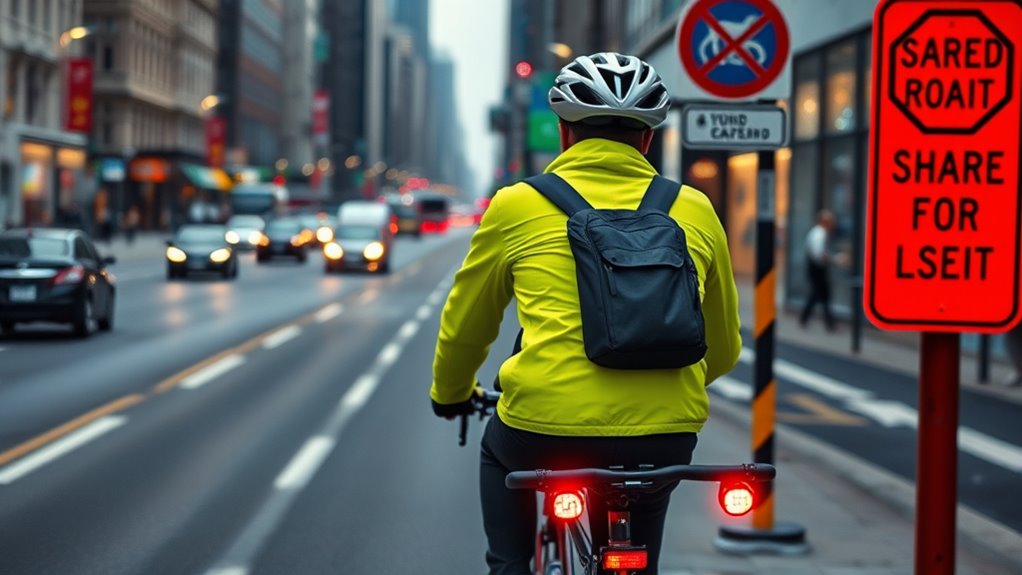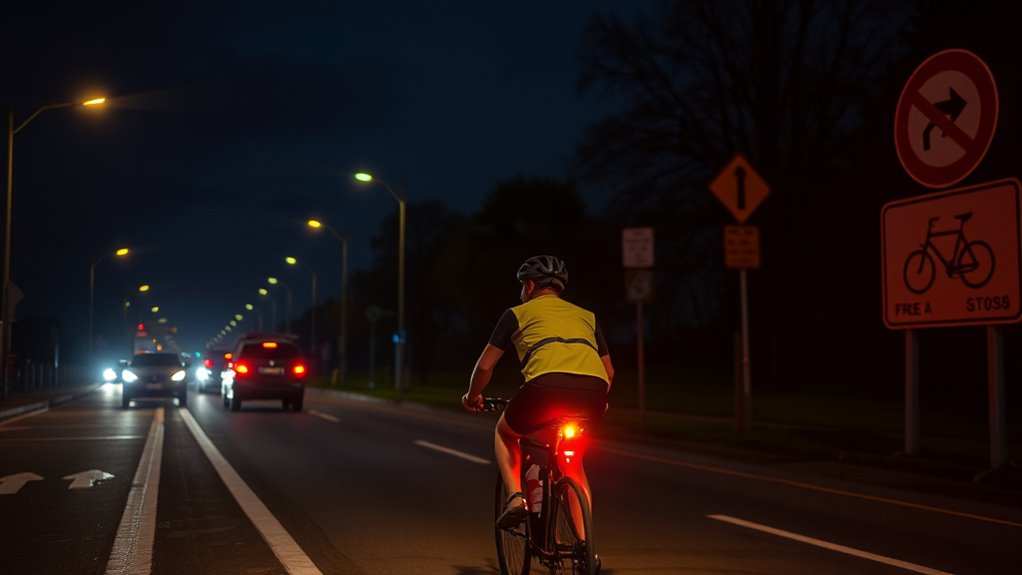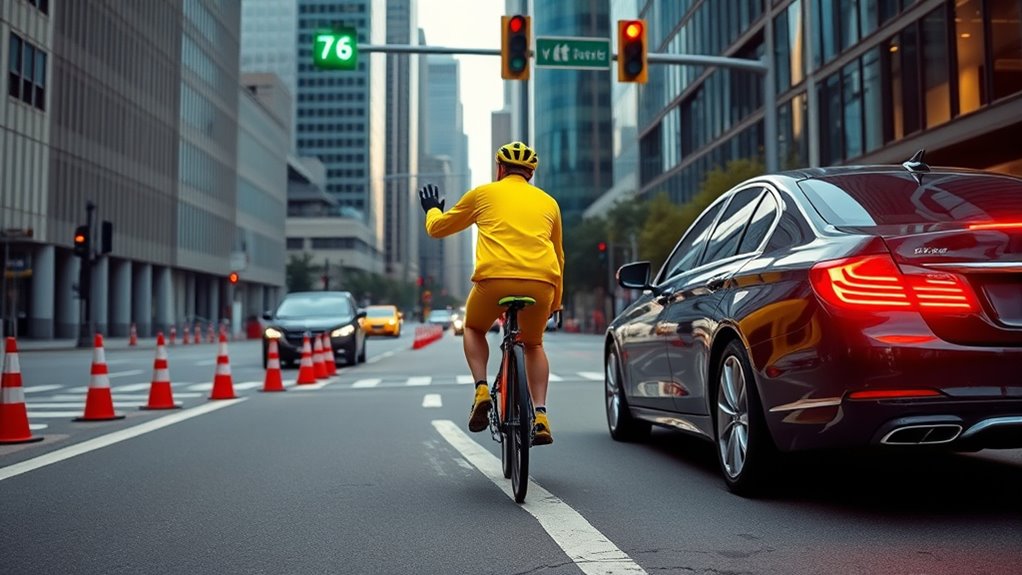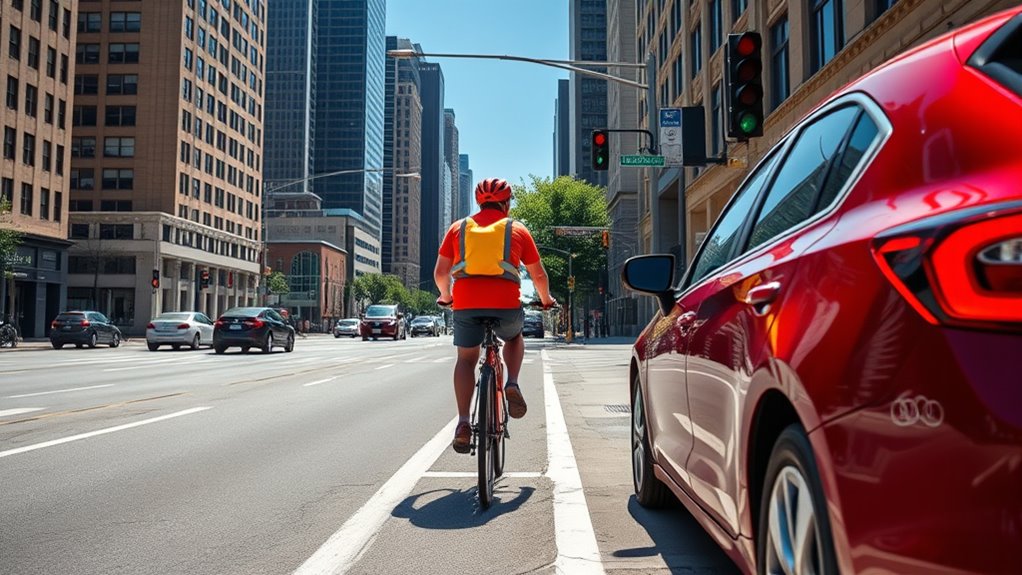In Texas, your bicycle is legally considered a vehicle, giving you the same rights and responsibilities as motorists. You have the right to use full lanes when needed, obey all traffic signals, and communicate your intentions clearly through hand signals and lights. Proper safety equipment, like reflectors and lights, is required, especially at night. Understanding these rights helps you stay safe and assert your position on shared roads—and there’s more to learn if you keep exploring.
Key Takeaways
- Cyclists are legally considered vehicles with the same rights and responsibilities as motor vehicles on shared roads.
- They have the right to use full traffic lanes for safety and navigation, including control lanes and bicycle lanes.
- Cyclists must obey all traffic laws, signals, and signs, and are required to use proper hand signals for turns and stops.
- Proper lighting, reflectors, and visibility gear are legally mandated, especially during night riding, to ensure safety.
- Cyclists can document violations of their rights and seek enforcement or legal action to protect themselves on the road.
Texas Law Recognizes Bicycles as Vehicles

In Texas, bicycles are legally considered vehicles, which means they have the same rights and responsibilities as motor vehicles on the road. Under Texas law, bicycles are classified as vehicles, granting you the legal right to share the road with cars and trucks. All traffic laws, including signs and signals, apply equally to bicycles when riding on the road. You can operate in a bicycle lane or control lane if necessary for safety, ensuring you follow the same rules as other vehicles. Riding on the road gives you the legal right to use the entire lane when needed, helping to increase safety and visibility. Texas law protects your rights as a cyclist, emphasizing that bicycles are vehicles with equal standing on the roadway. Understanding urban mobility can further support safe and legal cycling practices. Recognizing that bicycles are equivalent to automobiles under the law encourages respectful sharing of the road among all users. Additionally, proper safety equipment and adherence to traffic laws contribute to safer cycling experiences.
Cyclists Have Equal Rights and Responsibilities on the Road

As a cyclist, you share the road with motor vehicles and must follow the same traffic laws. You have the right to use full lanes and are responsible for obeying signals and stop signs. Both cyclists and drivers need to respect each other’s rights to make sure everyone stays safe. Understanding the Vetted – Halloween Product Reviews can help you recognize appropriate safety gear and costumes that ensure visibility and protection while cycling. Additionally, being aware of local store hours can assist in planning your rides and errands around safe and well-lit times. Regularly inspecting your bicycle’s performance metrics ensures safe riding conditions and helps prevent accidents. Proper maintenance and cleaning of your bike and gear is essential for safe and efficient cycling. Staying informed about electric bikes and their capabilities can also enhance your safety and riding experience, especially when sharing roads with various vehicle types.
Shared Traffic Responsibilities
Because cyclists are legally considered vehicles, they share the same rights and responsibilities as motor drivers on the road. You have the right to share a lane with vehicles when necessary for safety or proper navigation. Texas law requires cyclists and motorists to obey traffic signals, signs, and rules, emphasizing mutual responsibility. When riding, you must use hand signals to communicate your intentions, and drivers are legally obliged to respect these signals and give you adequate space. Proper lane sharing and adherence to traffic laws help ensure safety for everyone. Whether you’re on a bicycle or in a vehicle, understanding your responsibilities on shared roads promotes legal compliance and reduces accidents. Staying informed about these laws helps you navigate Texas roads confidently and responsibly. Additionally, understanding shared traffic responsibilities can help prevent misunderstandings and promote respectful coexistence among all road users.
Obey Traffic Laws
Since cyclists share the road with motor vehicles, following traffic laws is essential for everyone’s safety. As a cyclist, you must obey all signs, signals, and rules just like drivers. This includes stopping at stop signs and red lights, and using signals to indicate turns. Proper lane control helps prevent accidents and keeps traffic flowing smoothly. Remember, drivers are required to yield to you in traffic situations, recognizing your right to share the road. To emphasize this, consider the following:
| Traffic Law | Importance |
|---|---|
| Obey signs and signals | Ensures predictable actions |
| Stop at stop signs and red lights | Prevents collisions |
| Use signals for turns | Communicates your intentions |
| Respect lane control | Maintains safety and order |
| Yield when necessary | Avoids conflicts and accidents |
Following these rules keeps everyone safe and respects your rights as a cyclist.
Equal Road Access
Cyclists have the same rights and responsibilities as motor vehicle drivers on shared roads, which means you are legally permitted to use traffic lanes and control an entire lane when necessary for your safety. Bicycles are classified as vehicles under Texas laws, giving you equal rights on roads. You can ride in traffic lanes even if bike lanes are available, especially if they are blocked or unsafe. As a cyclist, you must obey all traffic signals, signs, and laws applicable to vehicles, just like drivers. Drivers are required to yield the right of way to you, recognizing your legal status as an equal road user. This ensures your safety and promotes fair sharing of roads, reinforcing that cyclists have equal rights and responsibilities on shared roads. Additionally, understanding your legal rights and responsibilities helps you navigate shared roadways more confidently and safely. Being aware of traffic laws for cyclists can further enhance your safety and legal compliance while riding.
Proper Lane Positioning and Sharing Practices

To share the road safely, it is vital to understand proper lane positioning and sharing practices. Lane sharing respects cyclists’ rights to control a lane when necessary for safety or turns, especially on single lanes or narrow shoulders. When riding, make certain your proper positioning makes you visible and predictable. If riding two abreast, stay within a single lane and avoid impeding traffic flow. When passing a cyclist, motorists must maintain a minimum of three feet of clearance, as required by traffic laws. Use signaling clearly to indicate your intentions. When riding, take the full lane if needed to prevent unsafe passing, and adjust your position to enhance safety for everyone. Following these practices promotes safer sharing and respects cyclists’ legal rights on shared roads. Studies show that security systems can help deter criminal activity around your home, just as proper lane positioning can help prevent accidents and ensure safety for cyclists and motorists alike. Recognizing the importance of road safety measures can further improve shared road interactions and reduce the risk of collisions. Additionally, staying informed about industry trends in traffic laws can help both cyclists and motorists adapt their behaviors for safer road sharing. Being aware of local cycling regulations can also promote compliance and enhance mutual respect among all road users.
Required Equipment and Safety Measures for Cyclists

To stay safe on shared roads, you need to meet specific equipment requirements. Make sure your bike has proper lighting and reflectors, especially for night riding, and always wear a helmet for protection. Using hand signals also helps communicate your intentions clearly to others around you. Incorporating appropriate safety gear can further enhance your visibility and security while cycling. Additionally, choosing high-visibility clothing can significantly improve your awareness by motorists during low-light conditions. Ensuring your bike is equipped with reflectors and lights is essential for visibility in various lighting conditions. Staying informed about Automated systems in transportation can help cyclists anticipate changes and improve safety on the road.
Essential Lighting Requirements
Are you aware of the lighting equipment required to stay safe and compliant when riding at night? Your bicycle must have a front white light visible from at least 500 feet to improve nighttime visibility. The rear should feature a red reflector or a red light visible from 300 to 500 feet behind; a red light can replace the reflector if it meets the same visibility standards. Proper lighting helps drivers see you from a safe distance, especially in low-light conditions. Your bike should also be equipped with reflectors to enhance visibility even when lights aren’t active. Additionally, if your bicycle is equipped with a brake, ensure the lighting setup doesn’t obscure it. Following these lighting requirements is essential for your safety and legal compliance on shared roads. Using high-quality lights can further increase your visibility and safety during nighttime rides.
Mandatory Safety Gear
Ensuring your safety while riding involves more than just obeying traffic laws; it also means wearing and using the proper safety gear. For night riding, your bicycle must have bicycle lights—white front lights visible from at least 500 feet and red reflectors or rear lights visible from 300 feet—to boost visibility. Reflectors and safety gear help other drivers see you clearly, especially in low-light conditions. Your brakes should be functioning properly, capable of skidding on dry pavement, to assure control. Wearing a helmet is strongly recommended, and in some areas, legally required for minors. Proper signaling is essential to communicate your intentions, while adherence to traffic laws and nighttime safety practices reduces your risk of accidents. Prioritize visibility and safety gear at all times.
Rules for Signaling and Communicating With Other Road Users

Effective communication with other road users is essential for your safety while cycling on shared roads. You must use clear hand signals to indicate your intentions, such as extending your left arm downward to stop or horizontally to turn left. Proper cycle signaling helps alert drivers and cyclists, reducing accidents. Remember, lights and reflectors don’t substitute signals; use both for better visibility. Signaling is required at intersections, in traffic lanes, and on bike paths, conforming to traffic laws. Consistent signaling ensures smooth road communication and helps prevent misunderstandings. Here’s a quick guide:
| Signal | Meaning | When to Use |
|---|---|---|
| Left arm horizontally | Turn left | Before turning |
| Right arm upward | Turn right | Before turning |
| Left arm downward | Stop or slow | When stopping |
| Bright lights | Increase visibility | Night or low visibility |
| Hand signals + lights | Max safety | All shared roads |
Night Riding Regulations and Visibility Requirements

When riding your bike at night or in low-light conditions, Texas law requires you to have proper lighting and reflectors to stay visible and safe. You must equip your bicycle with a front light, such as a white bicycle light, visible from at least 500 feet, and a rear reflector or light visible from 300 feet. A red rear light can replace a reflector if it’s visible from 500 feet behind. These lighting requirements are essential for nighttime safety and to comply with Texas bicycle laws. Bicycle lights and reflectors improve your visibility, making it easier for drivers to see you in low-light conditions. Ensuring your bike meets these visibility standards helps protect you and promotes safer shared roads during night riding.
Legal Protections and How to Assert Your Rights as a Cyclist

In Texas, bicycles are legally recognized as vehicles, giving cyclists the same rights and responsibilities as motor vehicle drivers on shared roads. You have the right of way when controlling a lane for safety, such as during turns or passing. Proper use of hand signals, front and rear lights, and adherence to traffic laws are key to asserting your rights and ensuring safe riding. If a driver violates your right of way, you can document the incident and seek legal protections through enforcement or legal action. Understanding these laws helps you confidently advocate for respectful sharing of the road and reinforces your legal protections. Consistently asserting your rights based on lane control and adherence to laws promotes safer, more predictable interactions on shared roads.
Frequently Asked Questions
Does a Cyclist Always Have the Right Away?
You might think a cyclist always has the right of way, but that’s not always true. It depends on the situation and whether they’re following traffic laws. If you’re riding legally, like obeying signals and signs, you generally have the right of way. However, if you’re violating rules, such as running a red light, your right of way can be lost. Always stay alert and follow the rules to stay safe.
What Are the Rules for Bicycle Riders in Texas?
In Texas, you must follow all traffic laws just like motor vehicle drivers. This means obeying signals, stopping at stop signs and red lights, and riding in traffic lanes when necessary for safety. You need proper lighting at night, use hand signals for turns and stops, and not carry more passengers than your bike can handle. Following these rules keeps you safe and legal on shared roads.
Can Police Stop You on a Bicycle?
Yes, police can stop you on a bicycle if they suspect you’ve committed a traffic violation, like running a red light or riding without proper equipment. They don’t need a warrant or probable cause to make the stop. When stopped, you can ask why you’re being pulled over and must follow lawful instructions. You’re also required to provide identification if asked and cooperate with law enforcement.
Do You Legally Have to Have a Bell on Your Bike?
You might think you need a bell to avoid trouble, but in Texas, that’s just a myth. The law doesn’t require cyclists to have a bell or any audible signal device. While adding one can boost safety, it’s perfectly legal to ride without it, as long as you’re using proper hand signals for turns and stops. So, no bell? No problem—your legal rights remain intact on shared roads.
Conclusion
Understanding your rights as a cyclist is like holding a key to the open road, granting you freedom and safety. By following Texas laws and practicing responsible riding, you steer through traffic with confidence and respect. Remember, you’re part of the lively mosaic of road users, each piece integral to the journey. Stay vigilant, communicate clearly, and enjoy the ride—your path is yours to navigate, brightening the road ahead with each confident pedal stroke.









